Bất cứ ai đã xử lý kinh doanh trong tài chính truyền thống có khả năng nhận thức được lợi nhuận và lỗ (PnL). Nhưng PnL trong thế giới tiền điện tử có giống nhau không? Khả năng hiểu các thuật ngữ như Mark-to-market (MTM), PnL nhận ra và PnL chưa thực hiện sẽ giúp phát triển sự
Nếu không có một quy trình được xác định rõ ràng để có được cái nhìn sâu sắc về lợi nhuận hoặc lỗ, giao dịch tiền điện tử có thể áp đảo, và các nhà giao dịch có thể phải vật lộn với những gì họ đang làm. PnL phản ánh sự thay đổi về giá trị của các vị thế của một nhà giao dịch trong một khoảng thời gian cụ thể
Hiểu được những điều cơ bản về PnL
PnL trong crypto đề cập đến việc tính toán lợi nhuận hoặc lỗ được thực hiện trên một khoản đầu tư tiền điện tử hoặc vị trí giao dịch. Đây là một số liệu được sử dụng để đánh giá hiệu suất tài chính của một nhà giao dịch hoặc nhà đầu tư trong thị trường tiền điện tử.
Để bắt đầu, dưới đây là một số thuật ngữ chính trong thuật ngữ PnL:
MTM
MTM đề cập đến quá trình định giá một tài sản hoặc công cụ tài chính dựa trên giá thị trường hiện tại hoặc giá trị hợp lý của nó. Ví dụ, trong bối cảnh giao dịch crypto, nếu một nhà đầu tư nắm giữ một lượng Bitcoin nhất định (BTC), giá trị của Bitcoin đó sẽ dao động dựa trên giá thị trường hiện tại
Công thức chung để tính PnL là:
Giả sử giá MTM cho Ether (ETH) hôm nay là $1,970, trong khi giá MTM ngày hôm qua là $1,950. Trong trường hợp này, PnL là $20. Nó cho thấy lợi nhuận là $20. Ngược lại, nếu giá MTM của ETH là $1,980 ngày hôm qua, nó cho thấy một sự mất mát của
Giá trị tương lai
Giá trị tương lai chỉ ra giá trị của một đồng xu kỹ thuật số tại một thời điểm tương lai trong thời gian.
Ví dụ, nếu một nhà giao dịch đặt cọc Tron (TRX) trị giá $1,000 với phần thưởng 4% hàng năm, người đó sẽ nhận được bao nhiêu sau một năm? Câu trả lời là $1,040. Tại thời điểm đóng đinh, giá trị hiện tại sẽ là $1.000, trong khi giá trị tương lai sẽ là
Sẽ có một giá trị hiện tại tại thời điểm mà nhà giao dịch cổ phần, nhưng nếu người đó xem xét tương lai như một tổng thể, có thể có vô số giá trị tương lai.
Có một cách khác để sử dụng giá trị tương lai là tốt. Các nhà giao dịch có thể yêu cầu đặt cọc bao nhiêu để có được $1,040 trong một năm. Nếu họ biết giá trị hiện tại và tương lai, họ có thể tính toán hệ số chiết khấu. Công thức tính hệ số chiết khấu là:
Đối với ví dụ được đưa ra ở trên, hệ số chiết khấu sẽ là:
PnL nhận ra
PnL nhận ra được tính toán sau khi các nhà giao dịch đã đóng vị thế của họ (bán tiền điện tử họ nắm giữ). Chỉ có giá thực hiện của các lệnh được tính đến trong PnL nhận ra, và nó không có mối quan hệ trực tiếp với giá nhãn hiệu
Giá nhãn hiệu là giá mà một hợp đồng phái sinh được định giá dựa trên giá thị trường hiện tại của tài sản cơ sở chứ không phải là giá mà hợp đồng đang được giao dịch.
Công thức cho PnL đã nhận ra là:

An example will help understand how to calculate realized PnL. If the entry price for buying X number of Polkadot (DOT) is $70 and the exit price is $105, the PnL for the period is $35, which refers to a profit of $35. However, if the closing price of the trade was $55, the PnL will be $15, but it will reflect a loss.
Unrealized PnL
Unrealized PnL refers to the profit or loss that is currently held in open positions but has not yet been realized through closing the position. The formula for determining unrealized PnL is:
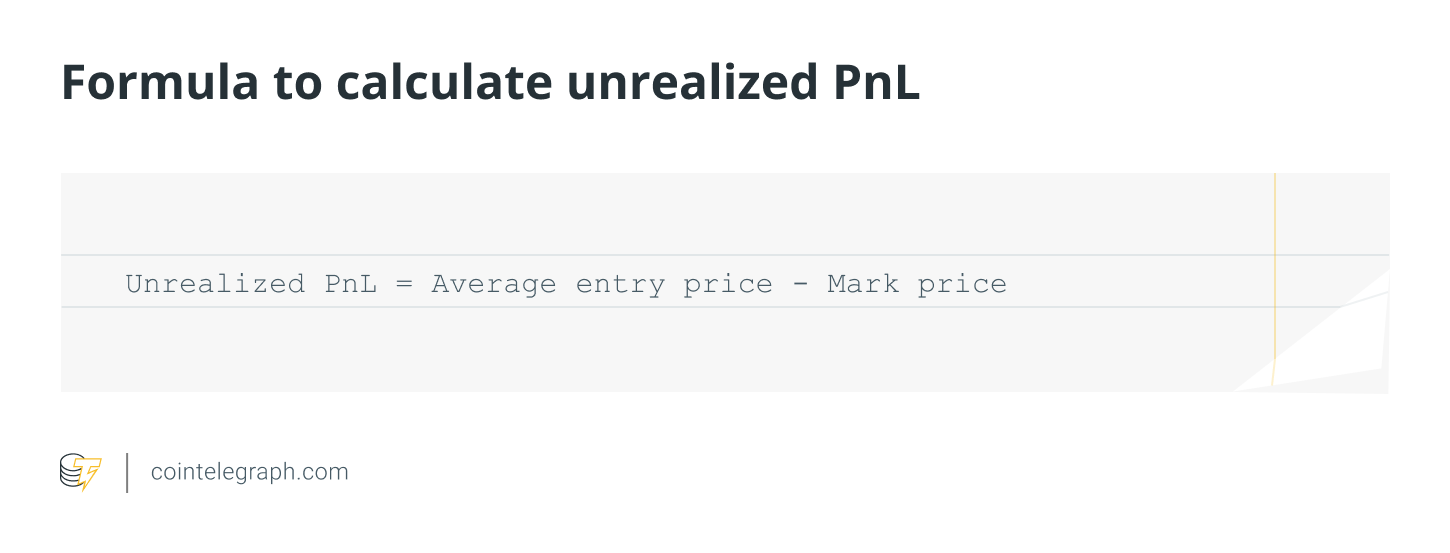
Donald has purchased ETH contracts with an average entry price of $1,900. The mark price of ETH is currently $1,600. The unrealized PnL for Donald is the difference between the average entry price and the mark price.
Unrealized PnL = $1,900 – $1,600 = $300
How to do PnL calculation
To determine PnL in cryptocurrency, a trader needs to find the difference between the initial cost of acquiring a digital coin and the current market value of the same coin. Various methods to calculate PnL in cryptocurrency are as follows:
First-in, first-out (FIFO) method
The FIFO method requires the seller to use the price of the asset from when it was first bought. Here is the process to calculate PnL using the FIFO method:
1) To settle on the initial cost of the cryptocurrency, multiply the purchase price per unit by the number of units sold.
2) To determine the current market value of the asset disposed of, multiply the current market price per unit by the number of units sold.
3) To find the PnL, deduct the initial cost from the current market value.
Suppose Bob first bought 1 ETH at $1,100 and a few days later bought 1 ETH at $800. A year later, he sold 1 ETH at $1,200. As he had first bought ETH at $1,100, this price will be considered the initial cost. Applying the FIFO method, Bob could calculate PnL as follows:
Bob’s initial cost = (1 ETH x $1,100) = $1,100
Current market value = (1 ETH x $1,200) = $1,200
PnL = $1,200 – $1,100 = $100 (profit)
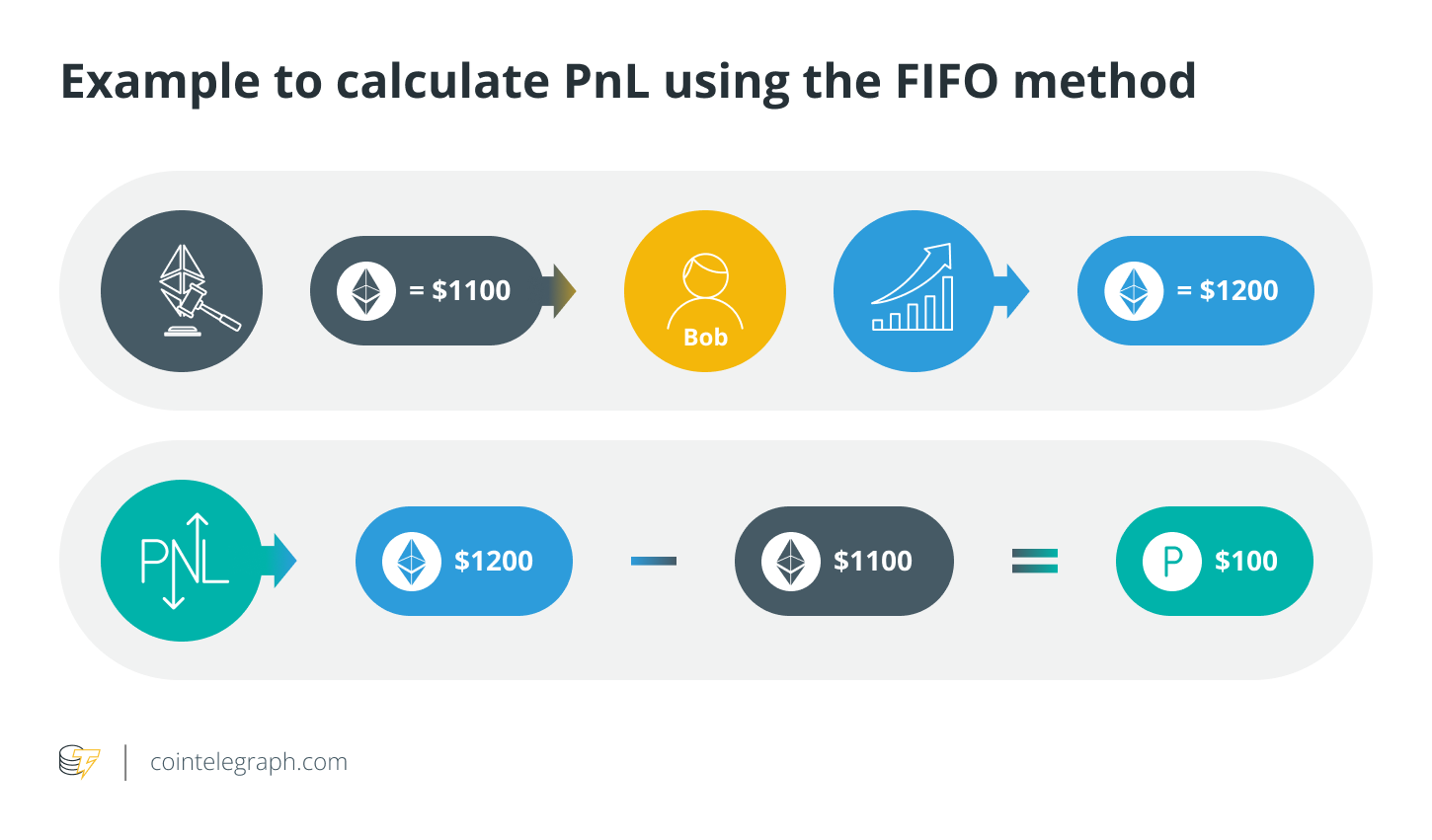
Last-in, first-out (LIFO) method
The LIFO method requires the seller to use the most recent purchase price of an asset in the calculation. The other aspects are just like the FIFO method. Here is the PnL using the LIFO method using the same example as above:
Bob’s initial cost = (1 ETH x $800) = $800
Current market value = (1 ETH x $1,200) = $1,200
PnL = $1,200 – $800 = $400 (profit)
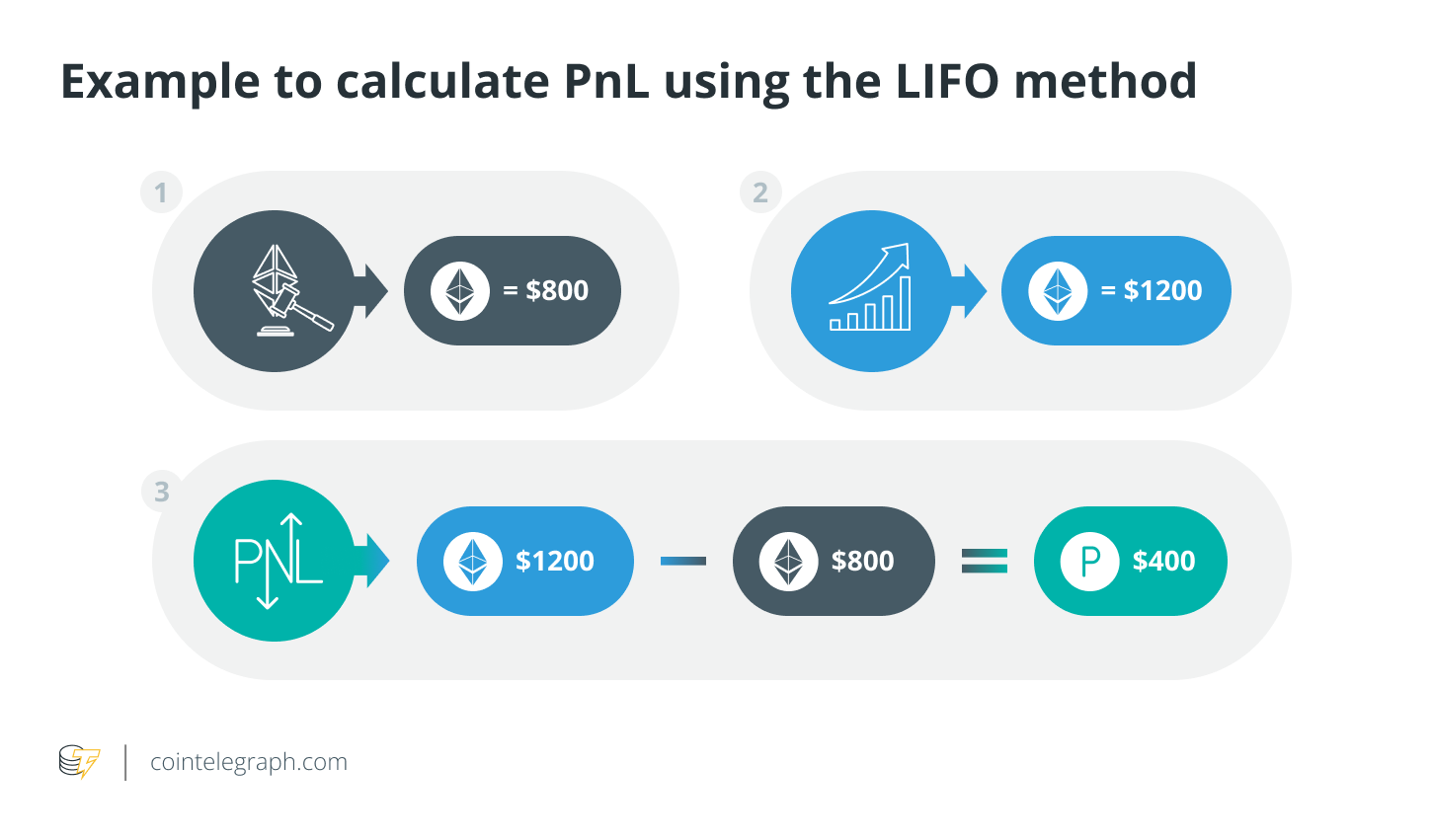
Weighted average cost method
The weighted average cost method requires traders to determine the average cost of all units of a digital currency in their portfolio to arrive at the initial cost. Here are the steps to calculate PnL using this method:
1) Determine the total cost of all units of the cryptocurrency. Multiply the purchase price per unit for each transaction by the number of units of the asset and add the numbers.
2) To arrive at the weighted average cost per unit of the digital coin, divide the total cost of all units by the number of units.
3) Find the current market value of the cryptocurrency sold. Multiply the current market price per unit by the number of units sold.
4) To determine PnL, subtract the average cost per unit from the current market value.
Suppose Alice bought 1 BTC at $1,500 and a few days later bought 1 BTC at $2,000. She later sold 1 BTC at $2,400. Here is the PnL using the weighted average cost method:
Total cost = (1 BTC x $1,500) + (1 BTC x $2,000) = $3,500
Weighted average cost = $3,500 / 2 BTC = $1,750
Current market value = (1 BTC x $2,400) = $2,400
PnL = $2,400 – $1,750 = $650 (profit)
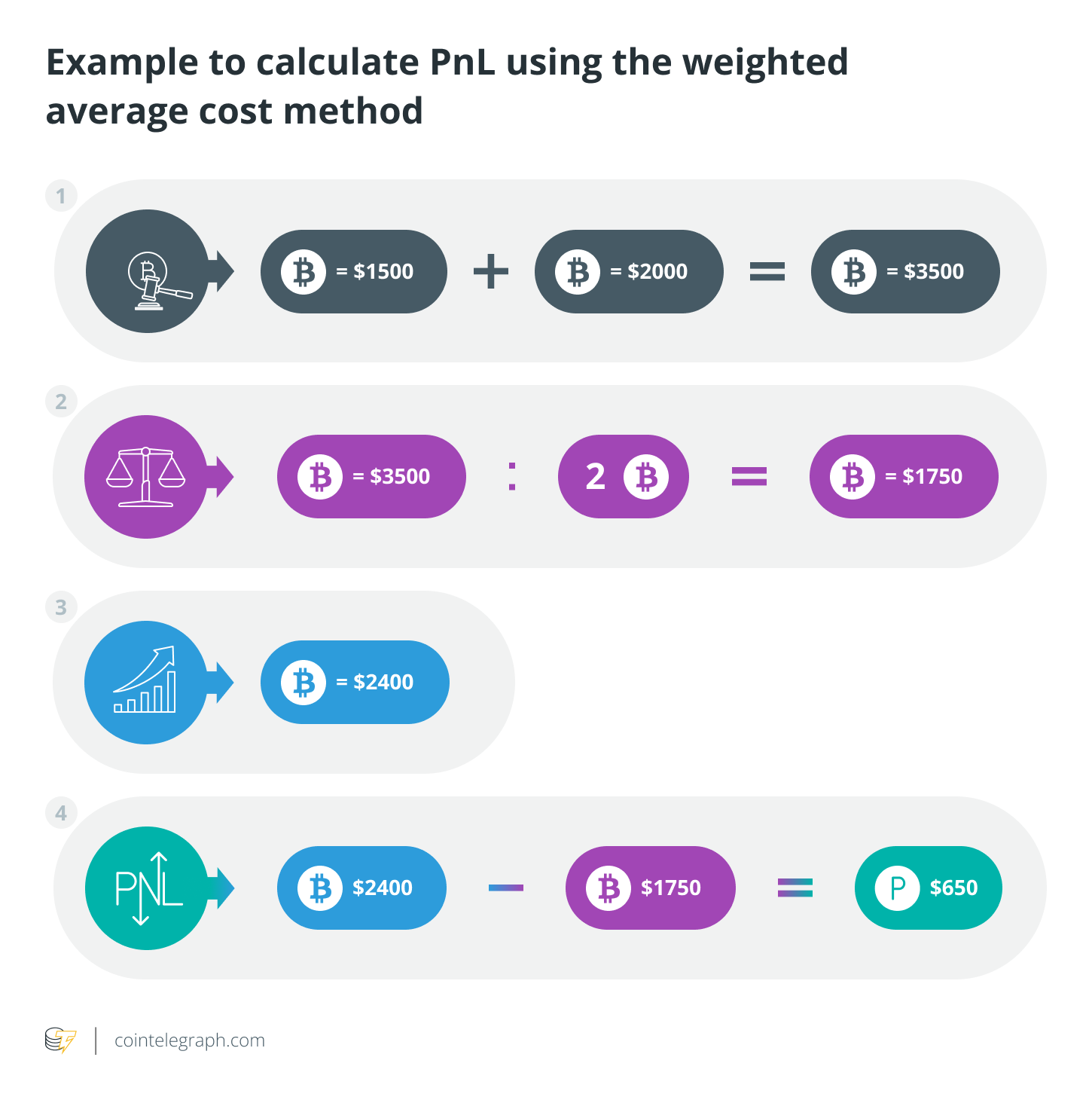
Profits/losses from opening and closing positions
Analyzing open and closed positions at regular intervals is an efficient way to monitor performance. An initial purchase a person makes in the market is an open position, while selling the cryptocurrency is termed closing the position. If a trader buys 10 DOT, it is an open position. When the trader sells those DOT, the position gets closed.
Ví dụ, nếu một nhà giao dịch mua 10 DOT với giá 70 đô la và bán chúng với giá $100, PnL của người đó sẽ là $30 ($100 – $70). Phân tích thường xuyên các giao dịch phù hợp với các vị trí mở và đóng sẽ giúp một người giao dịch một cách có tổ chức.
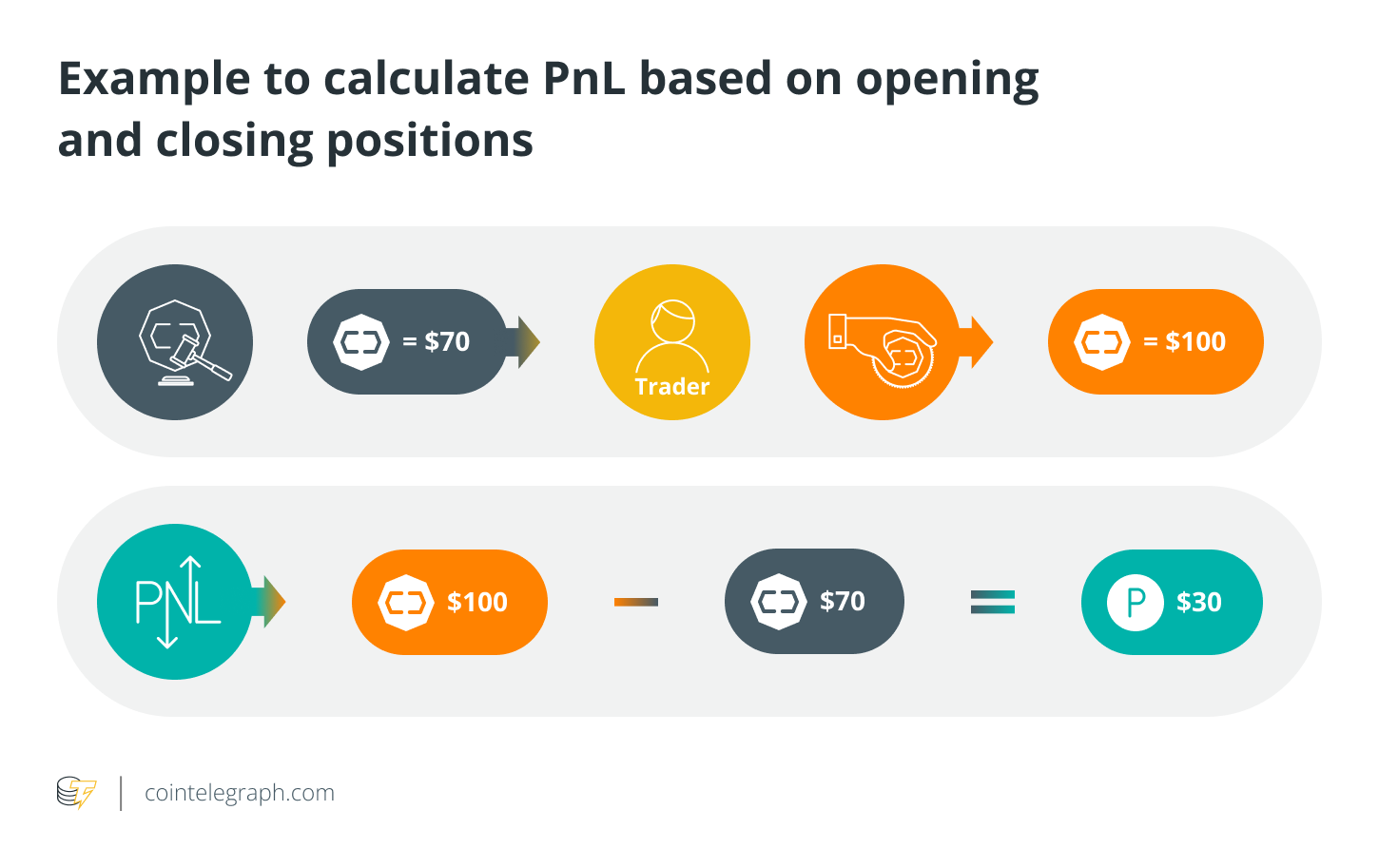
Year-to-date (YTD) calculation
YTD is a way to measure the performance of investments made in cryptocurrency from the start of the year to the current date. Investors who regularly buy and hold cryptocurrencies for years can know their unrealized profits with a YTD calculation. The trader just needs to calculate the value of the portfolio at the beginning and end of a year and compare these values. This could be a calendar year or fiscal year, depending on the person’s preference or requirements.
Suppose someone holds $1,000 worth of Cardano (ADA) on Jan. 1, 2022 and $1,600 of ADA on Jan. 1, 2023. In this case, $600 is the unrealized profit. Unrealized profit denotes returns that haven’t yet been converted into cash or cash equivalents such as term deposits.
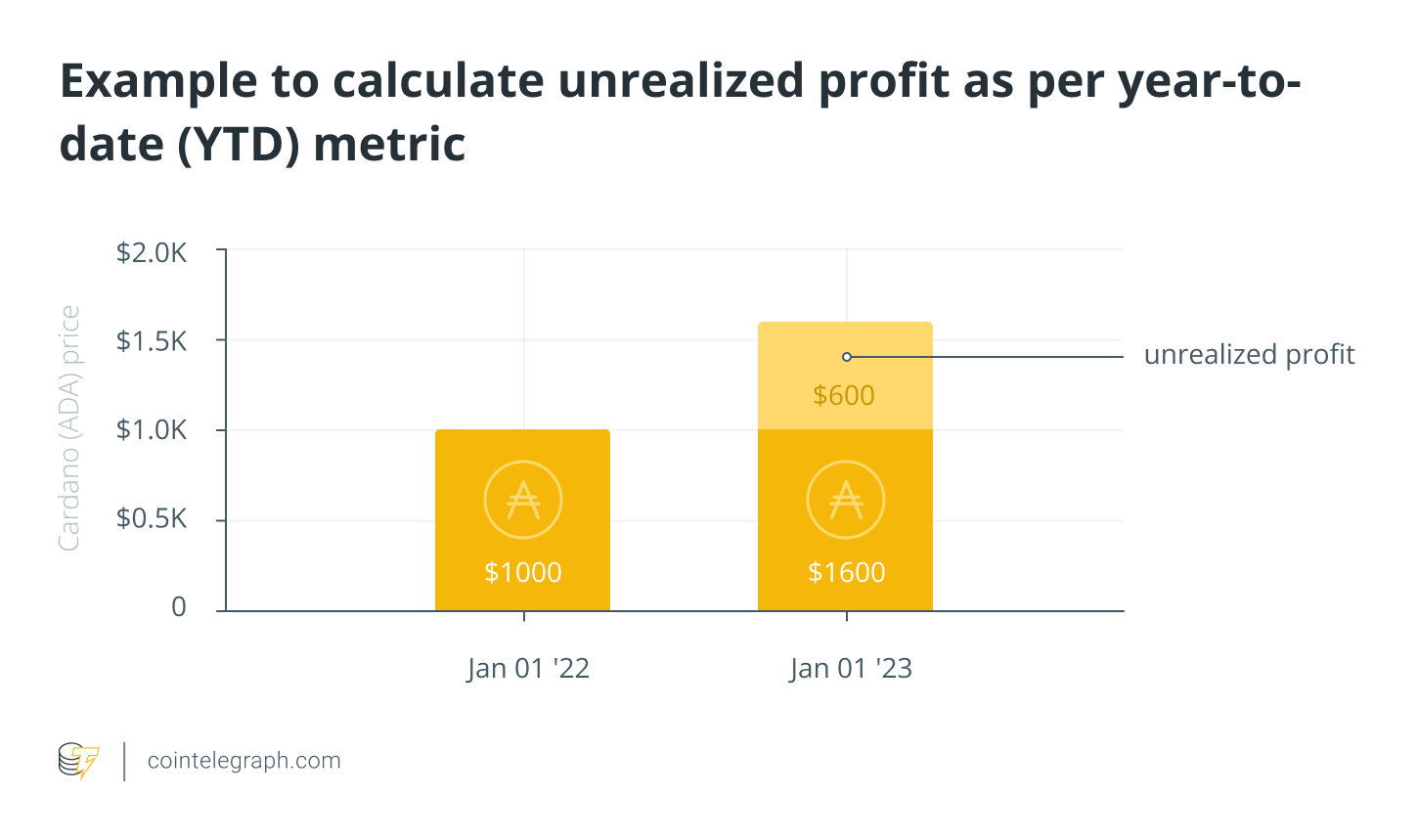
Transaction-based calculation
A transaction-based calculation requires a person to calculate the PnL for each specific transaction. For instance, if a person bought 1 ETH for $1,000 and sold it for $1,500, the PnL for the transaction would be $500 profit ($1,500 – $1,000). If the number of transactions is small and a trader needs to calculate PnL for these transactions separately, a transaction-based calculation is an ideal method.
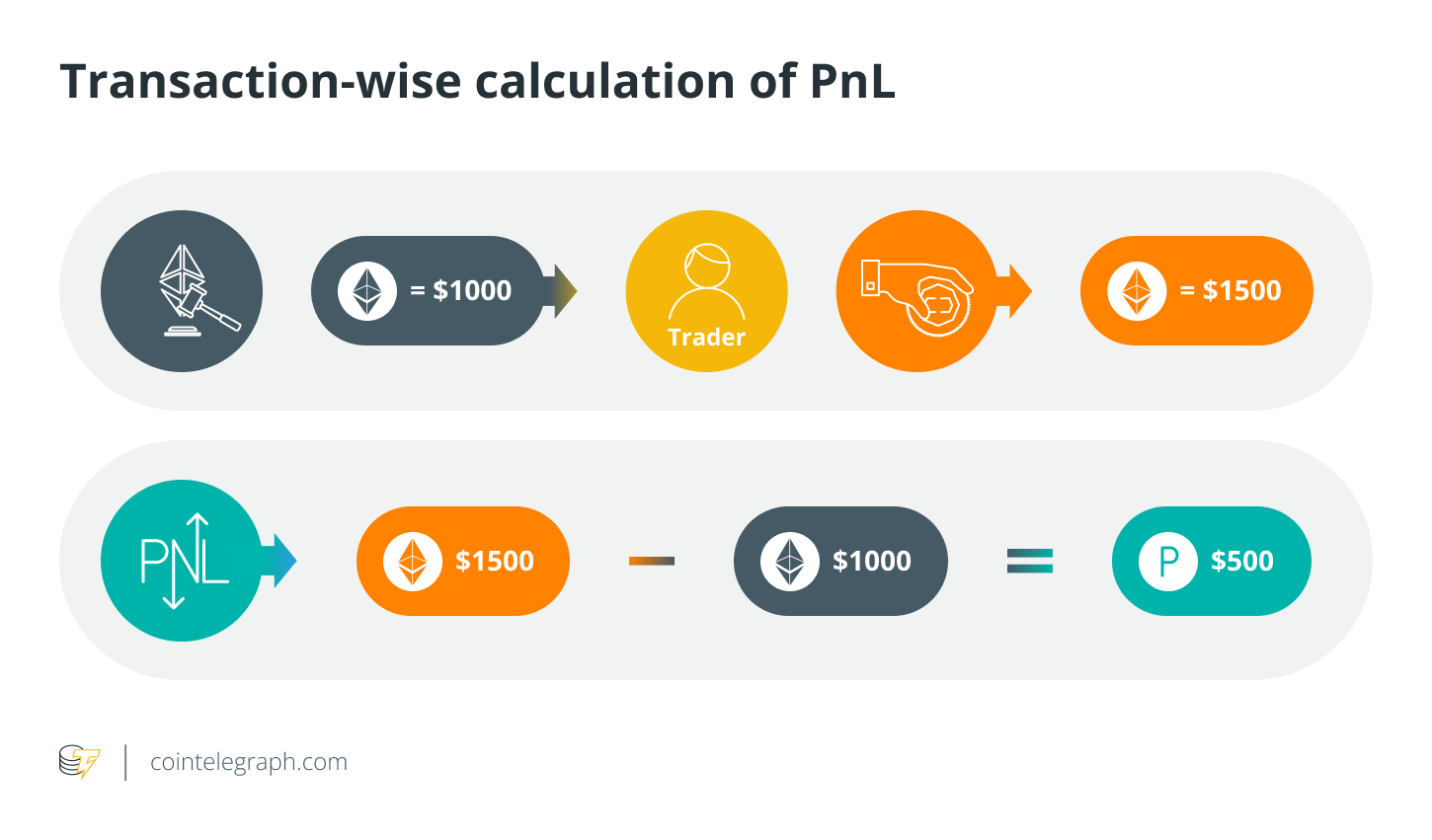
Percentage profit
The percentage profit method reflects the PnL as a percentage of the initial cost. An example will help understand better. Suppose a trader buys 1 Binance Coin (BNB) for $300 and sells it for $390. In this case, the person’s PnL would be $90 profit ($390 – $300). To arrive at the percentage profit, the trader needs to divide the PnL by the purchase price and multiply the amount by 100 (($90 / $300) x 100). This amounts to 30%.
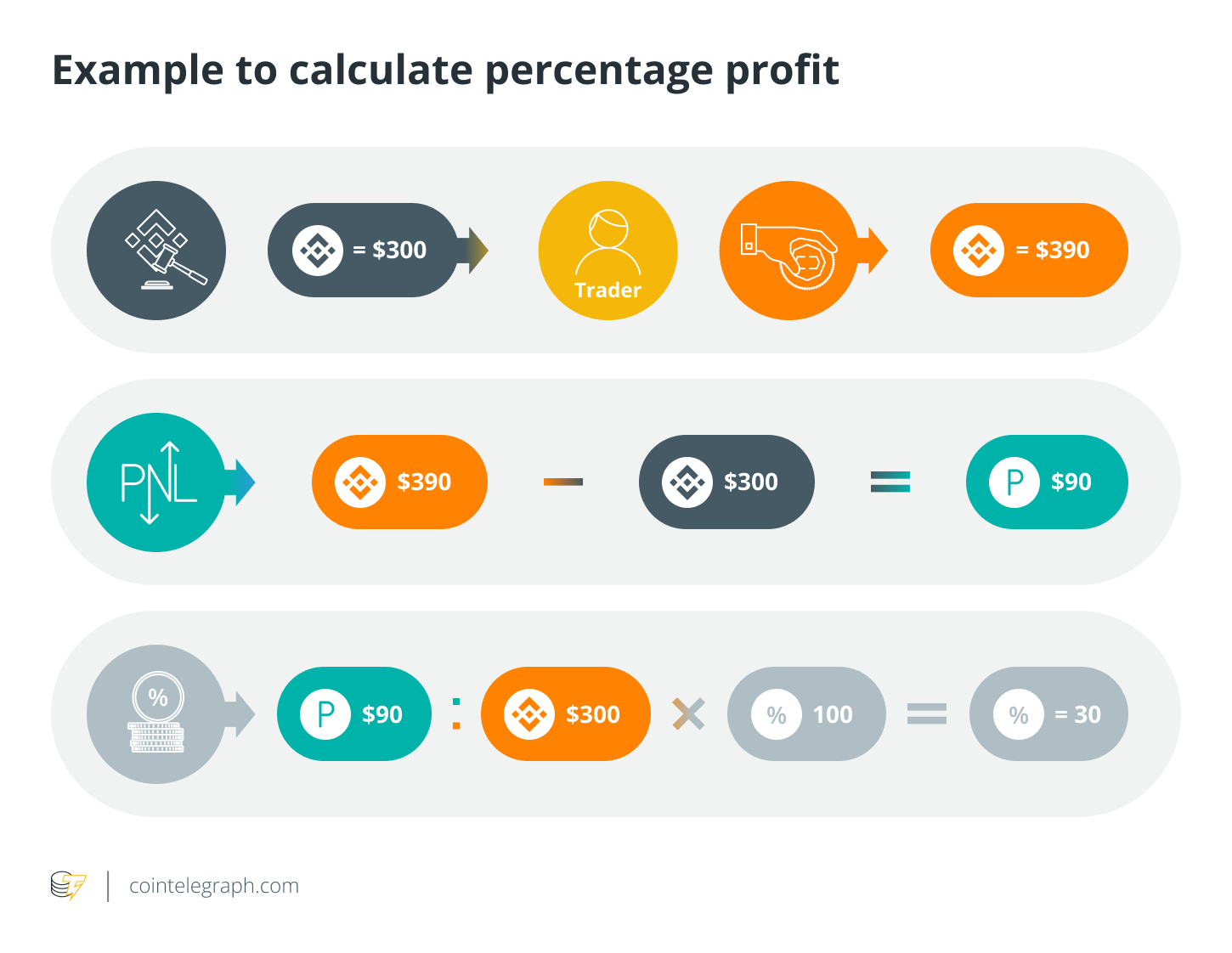
However, please note that these are simplified examples that do not factor in variables such as taxes, trading fees paid to the platform, market volatility, etc. In real-life situations, a trader will need to take into account the specific context when calculating PnL.
How to calculate PnL of perpetual contracts
Perpetual contracts are a type of futures contract with no fixed settlement time or expiration date. Traders can hold their long or short positions indefinitely, provided they have sufficient maintenance margin, which is the minimal amount of collateral needed for maintaining open trading positions.
When traders calculate the PnL of perpetual contracts in cryptocurrencies, they need to calculate both realized and unrealized PnL and then add them to determine the total PnL.
Here are the steps to measure PnL of perpetual contracts:
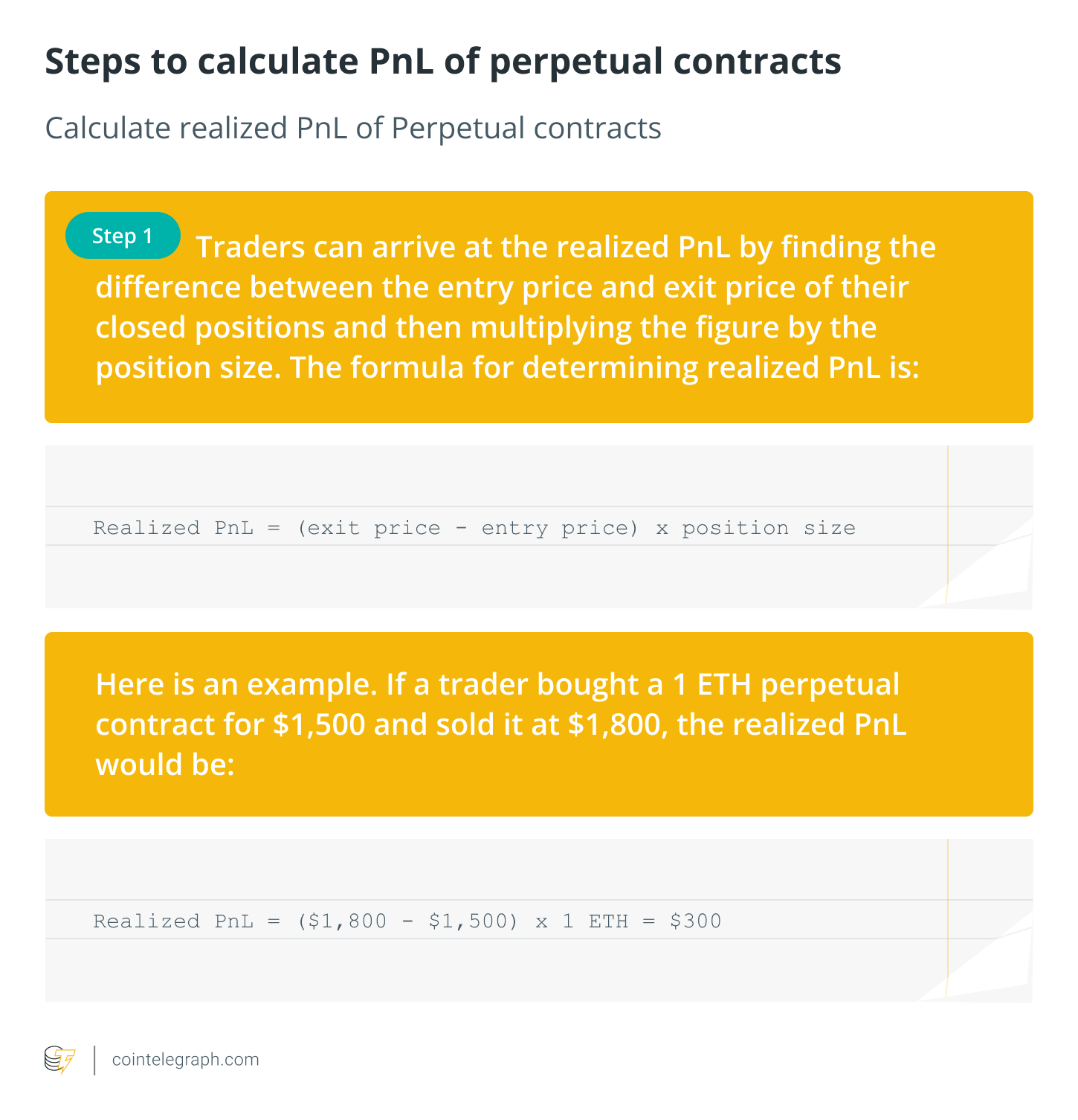
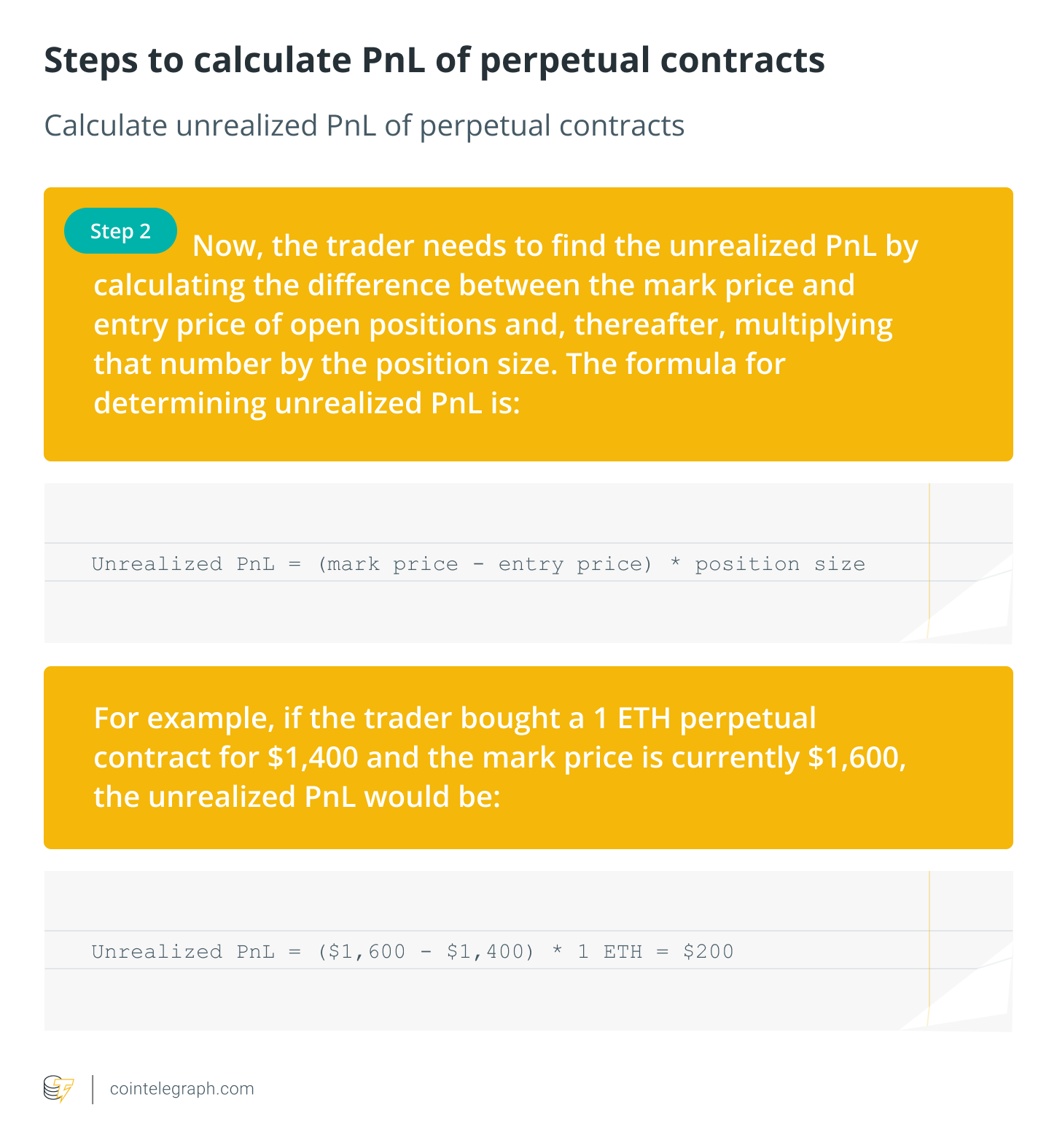
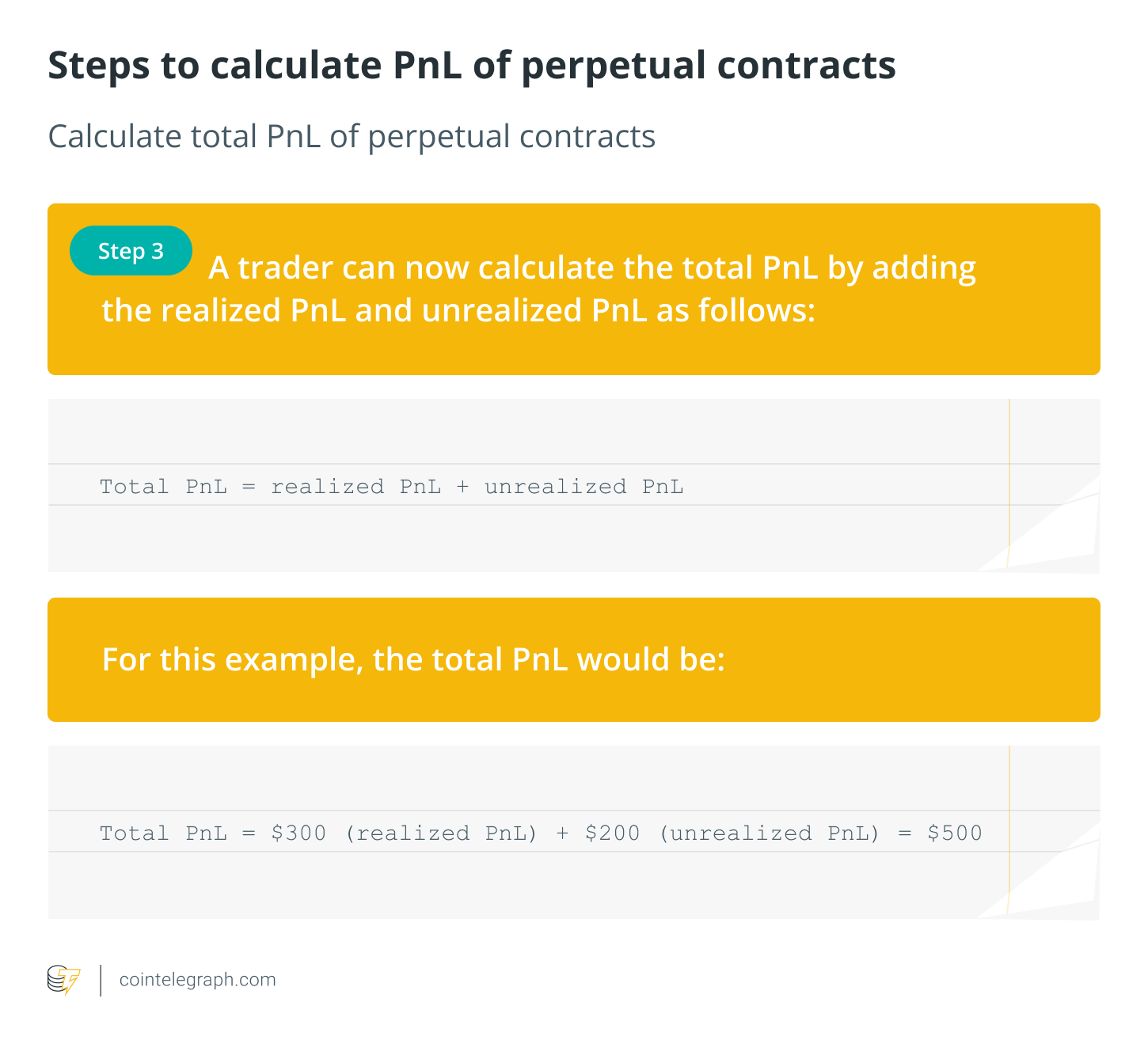
Again, this is a simplified way to explain the concept of calculating PnL for crypto perpetual contracts. When calculating total PnL in real life, a trader needs to take into account factors like trading fees and funding rates.
PnL calculations and associated tools
Understanding crypto PnL helps people know if their cryptocurrency portfolio is in profit or in loss. Gaining an insight into key parameters like cost basis, quantity, price of each trade and profitability of the portfolio helps traders assess the efficiency of their strategies and make necessary adjustments. Precise knowledge of the funds they have made or lost on a particular trade influences their upcoming trading decisions for the better.
Apart from PnL calculations, there are tools like specialized spreadsheets and automated trading bots that could help traders analyze their performances and zero in on profitable trading opportunities, regardless of their experience.

























